Washburn Wire Factory, Harlem NY
October 19th, 2002 by Bad Guy JoeThe Washburn wire factory in Harlem was the very likely the largest factory in Manhattan. After production shut down, the factory became a haven for drug addicts and the homeless - a vast 'mad max' wasteland where not even the police would enter.
History
The Washburn wire factory produced everything from coat hangers to wire for Amtrak's northeast corridor and wiring for cars. It sat as an abandoned wreck from the time of its closing 1981 until 2004, when all of the buildings were bulldozed to make way for the East River Plaza mall. It employed anywhere from 600-1200 employees during its production peak. In the end it only employed around 250 workers.
It seems the original Washburn wire factory shut down in 1976. It was bought by a group of black entrepreneurs under the name 'Harlem Community Council, Inc. who felt it could be made profitable. Their dream of preserving manufacturing jobs in Harlem was noble, yet flawed. (HCC & Washburn are profiled in the November 1978 issue of Black Enterprise)
In mid 1978 Washburn Wire Products Inc a Federally financed minority owned enterprise was established to produce prestressed concrete steel wire strand in Harlem In New York City In 1978 this firm secured a contract to supply this product to Amtrak for use in the manufacture of concrete ties in the Northeast corridor The firm had a rated capacity to produce million pounds of prestressed concrete steel wire strand in 1978 two thirds of this capacity was dedicated to the Amtrak contract Washburn's bid for this business was well below the next lowest bid which was submitted by Florida Wire According to counsel for Florida Wire at the beginning of the delivery period under the contract Washburn was not able to meet the quality requirements of the specifications To perform its contractural obligations Washburn purchased prestressed concrete steel wire strand from Florida Wire at the latter s price After a time Washburn was able to meet the quality standards and for a period of about 6 months the company made deliveries to Amtrak from its own production Quality and financial problems continued however and on January 30 1981 the firm filed for bankruptcy In September 1981 the firm's assets were sold in a bankruptcy sale
Source: "Pressurized concrete steel wire strand from Brazil, France, and the United Kingdom" - United States International Trade Commission, Abigail Eltzroth, Howard Gooley - 1982
Between 1981 and 2003, the Washburn wire factory "had been the focus of a succession of failed development schemes, including plans for a movie production studio."
Source: http://www.nytimes.com/1998/03/29/nyregion/retail-center-is-proposed-in-east-harlem.html
In the late 1990s, a plan for bulldozing the Washburn wire factory and create a mall was hatched. It wasn't until late 2003 that demolition went into full swing. Several years later the East River Plaza opened, with anchor stores such as Target and Home Depot leasing out space. With it's demolition, NYC lost one more manufacturer, and with it, a working class lifestyle of steady pay and union jobs.
Adventure: (Original Writeup from 2002)
AHOY, The Washburn wire factory from hell is on the horizon! But not fer long matey!
The Washburn wire factory is well known to anyone who has driven along the FDR drive in Harlem. It's a massive set of 4 tall brick buildings, all long abandoned and all linked via overhead passages which are of questionable stability. Given the economics of the surrounding area, it should be of little surprise this location is both extremely accessible, inhabited by King Cobra swilling squatters, and often used for various (ill)legal activities. It is 5 stories and 4 buildings worth of criminal playground. And while that might scare some, it seemed like home to some of us... well... after we got past the fresh steaming loaf of shit someone laid in the front doorway...
The first floors are the most heavily graffiti damaged, while even one level up you will find surprisingly bare, clean walls with peeling lead paint on them. Only the most hardcore of graffiti cats seem to have bothered climbing high to the rooftops of these structures, sprinting over the piles of used, aids ridden needles that heroin users have discarded in shockingly huge piles all over these buildings. Some areas around and in the steps contain human waste as well - perhaps someone reverting back to animal instinct to mark their territory. (If that was the case, someone shoulda handed them a few cans of rusto. at least it smells better!).
We press onward, examining the open areas which, without windows, are quite breezy and fresh. In the darker, smellier corners are where the squatters lurk, as if they were the C.H.U.D.s of the overworld. Occasionally they'll walk by you and mutter 'be careful' from a distance... as if that was even an optional course of action in a location such as this?
Just about all of the machinery that was in here is long gone. The once busy manufacturing floors have been filled instead with a strange mix of discarded porn, small children's toys, a few books and of course needles. Needles, needles, needles.
Phuntastic as it is, we depart... knowing we may not see it again... you see, the southernmost building is already being leveled, and there's a lot of talk in the news about building a shopping mall on the land... home depot, staples, etc.
And so the urban cycle of gentrification goes... grinding ever so slowly to pave over one more piece of NYC's despicable, unsightly and phuntastic ghetto history. We are probably some of the very few who will miss this place, and the fewer still who weaponized their rigs and tied on large boots to explore this god forsaken place. It's our job. It's what we do.
(Adventure writeup originally written in October 19, 2002, History written up 4/3/2013. Photos from a later visit in 2003).

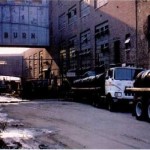
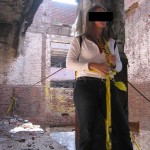

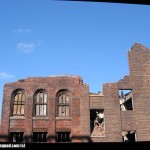
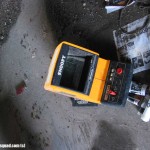
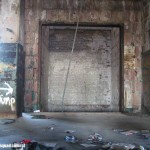

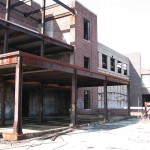
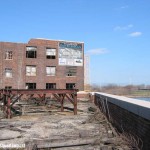
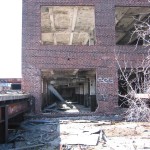
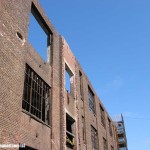
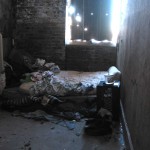
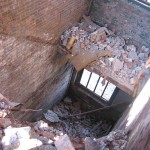
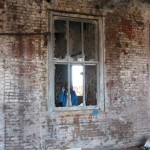

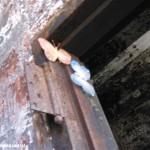

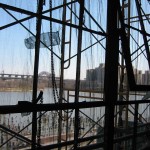
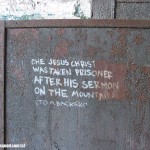
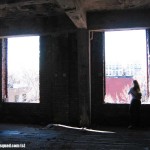
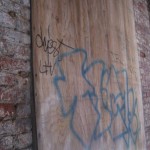
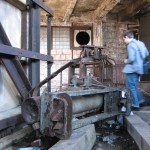
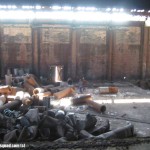

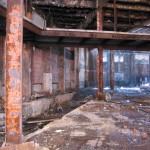
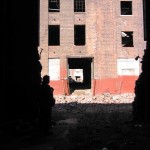
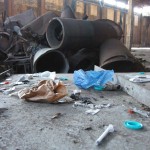

42 responses to “Washburn Wire Factory, Harlem NY”
As teenagers we used those buildings to test or bravery, these wee a dangerous series of buildings for more than a few reasons. I know some scary things were in there and from time time despite this knowledge,I muss the place too.
.
My Mom was raised at 118th St & Pleasant Ave.
She had 2 brothers that worked at Washburn.
Tough commute, half a block!
PegLegGuy
.
My mom worked as a secretary at Washburn Wire Company. She was raised on 116th and Pleasant Avenue. Probably worked there in the early fifties and had lots of great stories to tell.
Have pics of her typing away!
My grandfather and uncle lived in East Harlem and worked at Washburn for many years. Does anyone know what the average pay was for Washburn workers in the 1940s and 1950s? Also, any knowledge of the working conditions? Thanks for any info you can provide.
My father, uncle and grandfather all worked at Washburn Wire. My father from the early ’40’s until it closed. I lived on 116th Street until I was 5 years old.
Wow. I’d love to hear about what it was like working there, etc.
My Dad worked there from the early ’50s until his 1st heart attack in 1971. He took the train on Metropolitan Ave, Middle Village (Queens), into work. I’m not sure exactly what he made, except that it was about $20k when he was forced onto disability. I remember him talking about how hot the ovens were, where they heated the steel. He was a ‘wire drawer’, meaning, he drew the wire out of the furnaces and prepared it for spooling. He always talked about how he was making wire for the Verrazano Bridge cables! He was also a Shop Steward, since the union was big back then. I’m proud of the work he did and he was glad to be working with guys he liked. It allowed him to buy his own home, car, nice furniture and go on vacation! Not too many of these jobs left!
A school friend and his closest friend lured and murdered a mentally handicapped kid there back in 1992
Parts of the 1984 movie ‘Exterminator 2’ were filmed in and around that place.
My dad worked for Washburn for 36 years and just passed away in July at the age of 98. Can anyone tell me who I can contact about his pension.
Hi – sorry for your loss – I’m really not sure, hopefully someone else will know. Maybe there is something in his files 9assuming he kept some trace) or his bank would known (should be easy to track down a contact for regular deposits. I would imagine the fund was maintained by a financial services provider (fidelity, schwab, someplace like that). If any of his funds go unclaimed, they’ll be put in an account with the state – http://www.osc.state.ny.us/ouf/about.htm – you’d have to prove to them you’re related, but that seems easy enough. I’m not sure if other states do this (probably) or if it depends where he lived (say, NY vs NJ). In any case it would take some time (up to a year, maybe a bit more) for any missing money to show up there.
Nancy,
My father worked there from the early ’40’s until its closing. I know that he got a pension from the pension Guarantee Corp (Fed Government) and not Washburn Wire.
I believe that the Government under wrote the pension because foreign steel (stated reason)
drove them out.
Chris,
Yes. Parts of the movie Exterminator were filmed there.
My father who worked there helped them with facility support.
I have a spool of wire stating it was from the washburn factory. Steel wire about a 6 inch spool. If interested send email
My father, grandfather and brother all worked there. My family was from NYC but in the 60’s relocated to NJ and my dad and brother made the commute everyday. I remember when my dad lost his job in 76 and his pension was a third of what it was supposed to be. At one time it was a solid place to work and my dad raised/supported 3 kids and our mother on a single salary from that once great company.
The Washburn Wire Works was also a location for the cult classic film, “The Last Dragon” in 1984. The fight sequence at the end of the film was shot there. As a member of the crew, I can tell you it was a miserable place to film.
Interesting to hear the Washburn story. I lived on 116 and then 119, between First & Pleasant, from 1943-1963. Our family owned an extract store at 409 E 116. I think my dad’s teenage sister Adele, wss killed by a Washburn truck in 1937. Our family name is Ascione.
Correction. Adele died in 1927.
my grandfather worked there. They lived on E 117 near Pleasant Ave.
Back in the 70’s I hauled many a load of spooled wire from there to Detroit. The door you had to back into was a real pain for a semi with a 40 ft. trailer. Almost everything I hauled out went to Detroit with some going to West Jefferson, Ohio. the man in charge of loading was an old irisman named Grady.
My great-grandfather worked at Washburn. My family lived at 417 118th Street at Pleasant Avenue.
My gradfather my uncle and my father Frank
De Franco work there my father died at the age of 59 I truly believe that that factory had a lot to do with his short life span. His foot was burnt with hot lead and from that point on it was all down hill
But I do remember the union Christmas’s party were all the employees children got to sit on Santa’s lap take picture and get a gift still have the photos
Also remember the employees getting together on randels iland to play soft ball
My dad , Andrew Gordek, worked there until the strike and layoff in 76. I remember my parents having to take me out of Catholic highschool. I remember my mom having to use footsteps. My father nearly list an eye when one if the wires broke off and hit him in the face. My father also died at an early age.58. Never received a pension.
I work there for in 1973 & 1974 as summer help. That’s when the plant had its shut down for repairs. It was hot working in there
I shot a scene from my feature film NO EXIT there back in 1994.
OmG, my dad (wire roller) lived on Pleasant Ave/116th in a three-room cold water flat with his parents, one brother (priest) and five sisters (married). He and his dad worked at WW, all their life. When WW went under, dad received about $76/mo from the Pension Guarantee Fund. My husband and I still make the trip to Patsy’s – we love that pizza!
My husband bought 5 shares of the company. I wonder if they are worth anything
My dad worked at WW for many years and retired when the company changed hands. I worked there a few summers when they shut the plant down for annual maintenance and the guys in the machine shop brought their college age kids in to work as gofers and laborers. I developed a whole new respect when I saw what my dad had to do to take care of the family. There wasn’t a “safe” thing about working there by todays OSHA standards, but it was good, steady, well paying (for the time) work and lots of East Harlem residents of the 40s, 50s and 60s worked there.
Both my grandfather’s worked there, one retired in the 50s the other early sixties. They worked for a penny an hour there when they came from Europe. My grandfather on my mother’s side died from lung cancer in 1971. Talk about an osha nightmare.
My grandfather, Otto G. Onken was the chief engineer at WW from 1928 to 1961. I still have the ATMOS Perpetual Motion Clock that was given to him upon his retirement and is still running. He and my grandmother lived in White Plains and retired to Pompano Beach Florida. Many wonderful memories of them from the 60’s.
My grandfather, Peter Galbavy, is shown in the 1920 census to have worked at Washburn as a laborer. He, my grandmother, my mother and her younger sister lived at 519 E. 117th.
Anthony my beloved father in law Steve Simurda took us to many Xmas parties there too, how he loved his grand kids and kids. He too got hurt from hot steel in eye and lost eye and all downhill after that he died at 62 never got to retire on even one ss check
My great grandfather worked and died of a massive heart attack while working here. Haunting as I still go by the new shopping center often.
Yikes – KF, sorry to hear that.
The place must have been a real sweatshop. My grandfather worked there in the 1920s (his first job upon arriving in the U.S.) and quit when his foreman transferred him to another station, working at some kind of spooling machine that was notorious for maiming whoever operated it: cutting off fingers, taking out eyes.
My grandfather who was an immigrant from Hungary and worked at Washburn Wire Works from the late 1920’s through the Great Depression and longer. Family lore says that he and others remained employed but with reduced hours which was a better situation than many faced at other places of employment when they were simply let go. In the 1960’s my mother, my siblings, and I took the Circle Line around Manhattan. The sight of the old plant where she had met her father (my grandfather) after work from time to time brought her to tears.
No doubt it was hard work, but it was employment that my grandfather was grateful for. He was a tough individual having survived internment in a Russian prisoner of war camp. He learned enough Russian there to assist in his survival. By the grace of God and a sympathetic prison guard who looked the other way and allowed him to escape, my grandfather Joszef made his way from Siberia back to his farm in Hungary.
When he and his family arrived in New York City aboard the SS Leviathan in 1927, he found his first job by following a horse and cart to its origin and gaining employment tending to it and other horses in a stable. Whatever the hardships, which he never talked about, in part due to his lack of comfortable fluency in the English language, my grandfather was grateful for his employment at Washburn for decades.
My grandfather and father worked at Washburn wire. I remember the Christmas parties. Sitting on Santa’s lap. Seeing the plant Every time we visited my grandparents. My grandpa was the president of the union there. When they closed in 1976, my father loss his pension as well. My uncle also worked there for a few years. Sad when he lost his job.
My Dad, Joseph Mallone worked at WW from the tome he arrived from England ,around 1918, to his retirement in 1974. He was a stationary engineer. As others have said his pention was limited and only because of the legislation that came about around the same time. We lived in the eastern edge of Queens and my Dad drove in to work. . Tolls on the Triboro bridge was a quarter. I’m a little sad cause we never went to any Christmas parties. I know my Dad was union and he received the union publication which I would read. Dad passed away just short of his 90th birthday. Lung cancer contributed to his demise.
My Grandfather Aniello Buglione worked there . We lived in 1117 Vincent Avenue. I always imagined what it was like to drive there and back and see it through his eyes. He loved the heat and just wanted to say thanks for this page. It’s amazing!
My Grandfather and Uncles worked there. They lived on East 119th St Harlem then moved to Long Island. My Uncle Al worked nights in the 70’s.
My father, uncle, cousins and grandfather all worked there. As a child I visited it once and it was a scary sight seeing the furnaces blazing.